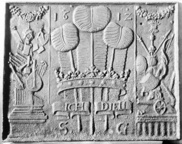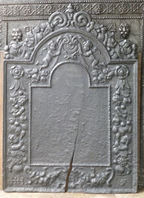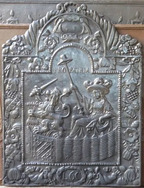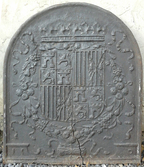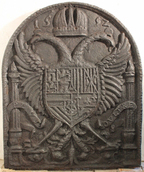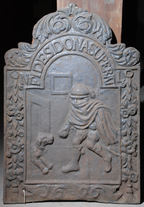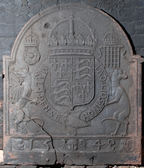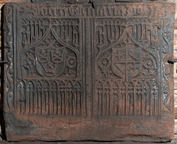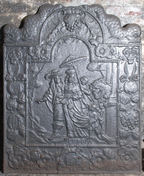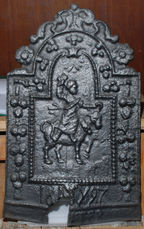-
1291
Description: Rectangular shape; astragal with cavetto-moulded edging; decoration in three vertical sections each divided by a fillet; central section: three ostrich feathers within a coronet and a motto scroll - ICH DIEN (I serve); at the top, the date split either side of the uppermost feather; at the bottom, initials - SG - split either side of the quills; left panel: on a pedestal, an arrangement of musical and scientific instruments and books below a floral swag with a central rose; right panel: on a palisade, a triumph of martial arms - cannon, drum, shield, spear, flag etc. - beneath a floral swag and handful of arrows.
Notes: The three ostrich feathers within a coronet and the motto, Ich Dien, are the badge of the Prince of Wales. Probably a fireback in honour of Henry Frederick, Prince of Wales, oldest son and heir of King James VI of Scotland, I of England, with the date added to commemorate his death in 1612. The initials are likely to be those of the pattern maker.
Inscription: 16 12 / ICH DIEN / S G
- Decoration tags:
- rectangular (shape)
- astragal with cavetto (edging)
- whole carved pattern
- individual numbers
- heraldic
- pictorial
- historical
- architectural
- royal
- text
- objects
Manufactured: in 1612 in the Eifel area of Germany.
Current location: not known.
Museum number: RBA 37533 (part of the Ahrgau-Museum, Ahrweiler museum group)
- Attached to series:
- Prince of Wales firebacks
- Miscellaneous royal firebacks
-
1004
Description: Arched rectangular shaped central panel with bead edging; arched rectangular border with bead edging; fructal and floral festoons suspended on ribbons with two putti at the top and two on each side; in the left and right bottom corners, the initials 'HH' and 'S' respectively; at the bottom, a central cartouche with date (indistinctly), between floral swags; on top, twin spirals between descending floral festoons.
Notes: A border panel, without the central pictorial panel.
Copies of this fireback are known.
Inscription: HH S
Manufactured: in 1665 in the Siegerland area of Germany.
Current location: not known.
- Attached to series:
- 'Dutch' HHS series
- Base boards
-
1212
Description: Arched rectangular central panel with bead edging; wickerwork Garden of Holland (Hollandse Tuin) within which is seated a berobed female figure holding a cap of freedom on the end of a long pole; before her is the crowned heraldic lion of the States General of the Netherlands, clutching a sheaf of arrows in its left front paw; above are the words, Pro Patria; arched rectangular border with fillet edging; central cartouche at top, with festoons of fruit, flowers and leaves suspended on each side from ribbons supported by rings; at the bottom, swirled ribbon around an oval compartment bearing the inscription 'L6C'; on top, a central cartouche from which descend a cornucopia on each side of the arch.
Notes: An overtly patriotic theme with symbols of Dutch nationhood; the inscription at the bottom indicates the style of border; other firebacks with the same inscription have the same border; similar inscriptions (e.g. L7C and L8G) indicate different borders.
Inscription: PRO PATRIA / L6C
- Decoration tags:
- 'Dutch' (shape)
- fillet (edging)
- whole carved pattern
- pictorial
- allegorical
- text
- animals
- humans
- plants
- objects
Manufactured: in the late-17th century in the Siegerland area of Germany.
Current location: not known.
- Attached to series:
- 'Dutch' LC/G series
- 'Dutch' Garden of Holland firebacks
-
145
Description: Arched shape; cavetto moulded edging; shield, crown, tassels and ribbons, of the combined kingdom of Castille, Aragon, Leon and Sicily.
Notes: Probably the arms of King Charles V of Spain; quarterly (1 & 4) Castille and Leon, (2 & 3) Aragon and Aragon-Sicily.
Inscription: 15 [?]0
Arms: Royal House of Trastámara (Spain)
- Decoration tags:
- rounded arched (shape)
- cavetto (edging)
- whole carved pattern
- armorial
- royal
Manufactured: in 1550 probably at Eisenschmitt Furnace in the Eifel area of Germany.
Current location: in private hands, Érezée, Luxembourg, Belgium.
- Attached to series:
- Foreign armorial firebacks
-
627
Description: Arched shape; cavetto moulded edge; double-headed eagle displayed, a Holy Roman Imperial crown above; in front, a quartered shield; a flaming pillar on each side, a motto scroll entwining each.
Notes: The shield bears the arms of Charles V, Holy Roman Emperor (reigned 1519-1556), king of Spain and nephew of Katherine of Aragon, Queen of England; the pillars are a symbolic representation of the Pillars of Hercules at the Strait of Gibraltar. Some variants of this fireback have a different date (e.g. see no. 1267) or none at all.
Copies of this fireback are known.
Inscription: PLVS OVLTRE [Further Beyond]
Arms: Charles V, Holy Roman Emperor
- Decoration tags:
- rounded arched (shape)
- cavetto (edging)
- whole carved pattern
- individual numbers
- heraldic
- armorial
- royal
- text
Manufactured: in 1592 possibly in the Eifel area of Germany.
Current location: Ashbourne, Derbyshire, England.
- Attached to series:
- Foreign armorial firebacks
-
844
Description: Arched rectangular central panel; fillet edging; pictorial scene of a cloaked figure, to the right, tempting a dog, to the left, with a tasty morsel; behind are the outlines of a door and window; arched rectangular border with fillet edging, the date along the bottom; down each side, a floral festoon; over the arch, the inscription, the initials split between each side of the main inscription; on top, floral scrolls.
Notes: The inscription translates as 'loyalty above gifts'; some castings omit the initials, NL, indicating that they were a subsequent addition. The illustration is derived from 'The thief and the dog', one of a series of engravings of Aesop's Fables by Wenceslaus Hollar.
Copies of this fireback are known.
Inscription: N / FIDES DONA SUPERAT / L // 1696
- Decoration tags:
- 'Dutch' (shape)
- fillet (edging)
- whole carved pattern
- individual letters
- planklines
- pictorial
- allegorical
- text
- animals
- humans
Manufactured: in 1696 possibly in the Siegerland area of Germany.
Current location: English Heritage Store, Atcham Business Park, Atcham, Shropshire, England.
Museum number: EH ASC 4491 (part of the English Heritage museum group)
- Attached to series:
- 'Dutch' 1696 NL series
-
207
Description: Arched rectangular shape; ovolo-moulded edge; Tudor royal shield, crown, garter and supporters (dragon and greyhound). Crowned rose on left, and crowned portcullis (grid of 16) on right side of crown; the supporters stand on a horizontal fillet; date panel with ovolo-moulding on top, central putto face splitting two parts of date with faces of putti in profile at each end.
Notes: Arms are of Edward VI. A very clear casting, almost certainly from the original pattern. There are several firebacks with the Tudor royal arms that were probably produced in the Spanish Netherlands, perhaps illustrating the association between England and Spain through the marriage of Henry VIII and Katherine of Aragon. The firebacks differ in several small details, such as the form and rotation of the Garter motto, the style of the crown, the positioning of the supporters in relation to the Garter, and the form and size of the crowned rose and portcullis.
Copies of this fireback are known.
Inscription: HONI SOIT QVI MAL I PENSE / 15 48
Arms: Tudor royal Edward VI
- Decoration tags:
- rectangular with round arch (shape)
- fillet (edging)
- whole carved pattern
- planklines
- heraldic
- armorial
- royal
- text
Manufactured: in 1548 possibly at Eisenschmitt Furnace in the Eifel area of Germany.
Current location: Ockwells Manor, Cox Green, Berkshire, England.
Citation: Kippenberger, A. 1973, Die Kunst der Ofenplatten (Düsseldorf, Verlag Stahleisen), p. 107.
-
810
Description: Rectangular; carved strip with undulating vine between fillets, repeated on each side; carved inscription panel along top edge; centre, two traceried panels, each with a central shield beneath a gothic arch.
Notes: One of several similar firebacks produced in the same period.
Copies of this fireback are known.
Inscription: JHESUS MARIA JHONES
- Decoration tags:
- rectangular (shape)
- fillet (edging)
- simple stamps
- carved stamps
- architectural
- armorial
- text
Manufactured: in the early-16th century possibly in the Eifel area of Germany.
Current location: in private hands, Cox Green, Berkshire, England.
- Attached to series:
- Foreign armorial firebacks
-
219
Description: Arched rectangular central panel with bead on fillet edging, pictorial representation of a man and woman walking, behind the woman a child holds her train and a young person carries a parasol; from behind a column on the right, a horse's head is visible, a tree stands to the left, at the foot of the scene is the word 'EUROPA'; arched rectangular border with fillet edging, from a central bunch of grapes at the top of the arch, a ribbon on each side suspends bunches of fruit and flowers; at the bottom a central cartouche containing the inscription 'L7G', with flowers on each side;; on top are two mirrored dolphins.
Notes: The pictorial scene is based on an engraving c.1642 of Friedrich Wilhelm, Elector of Brandenburg, and his wife, Luise Henriette of Oranje-Nassau, by Mathias Czwiczek; one of series of firebacks depicting allegories of the four continents; the initials, L7C, denote the style of border - other firebacks having the same inscription have the same border - and other borders are denoted by similar inscriptions (e.g. L6C and L8G).
Copies of this fireback are known.
Inscription: EVROPA / L7C
Manufactured: in the mid- to late-17th century in the Siegerland area of Germany.
Current location: Preston Manor, Brighton, East Sussex, England.
Museum number: HA105000 (part of the Brighton Museum museum group)
- Attached to series:
- 'Dutch' LC/G series
- 'Dutch' Continents firebacks
-
212
Description: Arched rectangular central panel, bead edging, female figure, her right arm raised, sitting on a bull; arched rectangular border, fillet edging, swags of fruit bunches suspended from ribbon, inscription below central panel; on top, symmetrical floral swirls and flowers; plain panel at bottom.
Notes: The image is of Europa being carried away to Crete by Zeus disguised as a bull.
Copies of this fireback are known.
Inscription: 16 NDW 97
- Decoration tags:
- 'Dutch' (shape)
- fillet (edging)
- whole carved pattern
- pictorial
- mythological
- monogram
- text
- animals
- humans
Manufactured: in 1697 in the Siegerland area of Germany.
Current location: Brighton Museum and Art Gallery, Brighton, East Sussex, England.
Museum number: HA105015 (part of the Brighton Museum museum group)
- Attached to series:
- 'Dutch' NDW series
